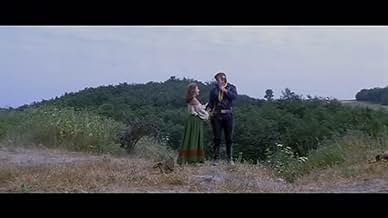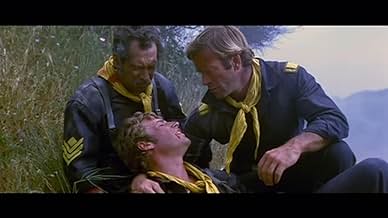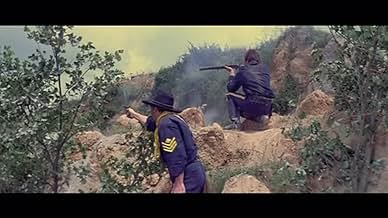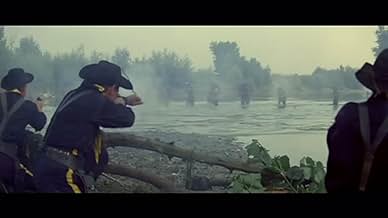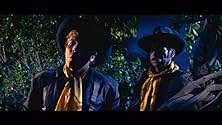IMDb RATING
5.1/10
341
YOUR RATING
A lone rider comes across a dying soldier, who gives him a paper authorizing the payment of $150,000 to the U.S. Army. The rider gathers some colleagues who disguise themselves as soldiers a... Read allA lone rider comes across a dying soldier, who gives him a paper authorizing the payment of $150,000 to the U.S. Army. The rider gathers some colleagues who disguise themselves as soldiers and who take the paper to a bank.A lone rider comes across a dying soldier, who gives him a paper authorizing the payment of $150,000 to the U.S. Army. The rider gathers some colleagues who disguise themselves as soldiers and who take the paper to a bank.
Alberto Cevenini
- Slim Kincaid
- (as Kirk Bert)
Gustavo De Nardo
- Sergeant Warwick
- (as Dean Ardow)
- …
Antonio Gradoli
- Captain Hull
- (as Anthony Gradwell)
- …
Gérard Herter
- Mr. Silver
- (uncredited)
Claudio Ruffini
- Sandy-Haired Gambler
- (uncredited)
Pietro Tordi
- Bartender
- (uncredited)
Featured reviews
Here Mario Bava , Master of the Macabre goes west in this exciting story dealing with Bill Mannerly : Ken Clark , who comes across a dying Northern Soldier who gives him a document authorizing the payment a large sum of money .The drifter joins some pals and all of them posing as soldiers to take the money at a bank . After that , they join up with US cavalry sent to pacify Indian tribes . Along the way he falls in love for a gorgeous prisoner called Janet : Jany Clair imprisoned in a wagon. Then, there takes places a series of incidents , including Indian attacks , fights , duels , assaults and anything else .The Adventure ...the violence ...of the savage West ¡
This is an ordinary Western about a simple and plain plot in which has great importance the regular confrontation between Cavalry and Indians . This good-natured Pasta Western contains thrills , romance , shootouts , crosses and double-crosses and action enough. It results to be quite entertaining but middling . Stars Ken Clark as an ambitious lone rider falling in love for beautiful Jany Clair and thanks to her he finds redemption, both of whom also starred Agent Secret FX 18 (1964) . Ken Clark was one of many American hunk men as Steve Reeves , Gordon Scott , Reg Park, Mark Forest , Reg Lewis, Dan Vadis , Rock Stevens , Lou Ferrigno, emigrated to Italy to play a Sword and Sandals or Peplum movies , though none of them topped in popularity to Steve Reeves . As Ken Clark getting a certain success in Peplum , and Euro-spy genre . Here Ken Clark is accompanied by a functional support cast , but none of them are known Western secondaries , exception for Gerard Herter who starred some classic Spaghetti Western . I miss the familiar faces regular in Spaghetti/Chorizo sub-genre . In "Road to Fort Alamo" stands out the splendid photography by Ubaldo Terzano and Mario Bava himself , full of brilliant blue and yellow colors, being shot in Elios studios , and exteriors from Lazio , Rome . As well as atmospheric musical score in Spaghetti style by Piero Umiliani.
The picture was regular but professionally directed by Mario Bava. He was the main creator of Italian Giallo genre , Bava (Blood and Black Lace, House of Exorcism, Black Sabbath) along with Riccardo Freda (Secret of Dr Hitchcock) and subsequently Dario Argento (Suspiria, Tenebre , Phenomena) are the fundamental representatives .In fact , Bava and Freda had a long collaboration , as Bava finished two Riccardo's films : Il Vampiri and Caltiki . These Giallo movies are featured by overblown use of color in shining red blood, usual zooms, and regular images-shock. Bava made all kinds of genres , such as Scifi : "Planet of vampires" , Peplum : "Hercules in the Center of Earth" , "Battle of Marathon", Historical : "Erik the Conqueror", "Viking massacre"and Spaghetti Western : "Roy Colt and Winchester Jack", "Ringo From Nebraska" codirected by Antonio Roman and this "Road to Fort Alamo". The movie will appeal to Mario Bava enthusiasts and completists.
This is an ordinary Western about a simple and plain plot in which has great importance the regular confrontation between Cavalry and Indians . This good-natured Pasta Western contains thrills , romance , shootouts , crosses and double-crosses and action enough. It results to be quite entertaining but middling . Stars Ken Clark as an ambitious lone rider falling in love for beautiful Jany Clair and thanks to her he finds redemption, both of whom also starred Agent Secret FX 18 (1964) . Ken Clark was one of many American hunk men as Steve Reeves , Gordon Scott , Reg Park, Mark Forest , Reg Lewis, Dan Vadis , Rock Stevens , Lou Ferrigno, emigrated to Italy to play a Sword and Sandals or Peplum movies , though none of them topped in popularity to Steve Reeves . As Ken Clark getting a certain success in Peplum , and Euro-spy genre . Here Ken Clark is accompanied by a functional support cast , but none of them are known Western secondaries , exception for Gerard Herter who starred some classic Spaghetti Western . I miss the familiar faces regular in Spaghetti/Chorizo sub-genre . In "Road to Fort Alamo" stands out the splendid photography by Ubaldo Terzano and Mario Bava himself , full of brilliant blue and yellow colors, being shot in Elios studios , and exteriors from Lazio , Rome . As well as atmospheric musical score in Spaghetti style by Piero Umiliani.
The picture was regular but professionally directed by Mario Bava. He was the main creator of Italian Giallo genre , Bava (Blood and Black Lace, House of Exorcism, Black Sabbath) along with Riccardo Freda (Secret of Dr Hitchcock) and subsequently Dario Argento (Suspiria, Tenebre , Phenomena) are the fundamental representatives .In fact , Bava and Freda had a long collaboration , as Bava finished two Riccardo's films : Il Vampiri and Caltiki . These Giallo movies are featured by overblown use of color in shining red blood, usual zooms, and regular images-shock. Bava made all kinds of genres , such as Scifi : "Planet of vampires" , Peplum : "Hercules in the Center of Earth" , "Battle of Marathon", Historical : "Erik the Conqueror", "Viking massacre"and Spaghetti Western : "Roy Colt and Winchester Jack", "Ringo From Nebraska" codirected by Antonio Roman and this "Road to Fort Alamo". The movie will appeal to Mario Bava enthusiasts and completists.
Italian movie director Mario Bava is best known for his horror movies. But during his career he found time to direct other kinds of movies, including spaghetti westerns, "The Road To Fort Bravo" being one such example. The movie is pretty unknown, and it's easy to see why. Throughout it has the feeling of a slapdash production. The budget was obviously pretty low, so the production values are pretty tacky, from the costumes to the poor special effects. Bava seems unable to show any visual flair on this project, except for a few scenes that take place in caves. But the main problem with the movie is the script. It feels like a first draft, with many scenes feeling rushed or unfinished. This quickie enterprise is capped with a pretty bad musical score by Piero Umiliani, which consists of 60s style music at its worst. The best that can be said of the movie is that its running time is fairly short.
A lone rider comes across a dying soldier, the victim of an Indian attack, who gives him a paper authorizing the payment of $150,000 to the U. S. Army. The rider gathers some colleagues who disguise themselves as soldiers and who take the paper to a bank. They get the money but a shoot-out occurs, an old woman is killed, and the gang acrimoniously splits up. Later some members of the gang meet up with some real U. S. Cavalry soldiers.
Ken Clark stars in this Spaghetti Cavalry western which has more in common with the American western. Clark's character goes through some transformation during the course of betrayal, double crosses and romance. It's a serviceable western, well shot with some decent action and drama, but it can also plod and meander. Dull moments do appear, but the characters and action keeps things going.
Ken Clark stars in this Spaghetti Cavalry western which has more in common with the American western. Clark's character goes through some transformation during the course of betrayal, double crosses and romance. It's a serviceable western, well shot with some decent action and drama, but it can also plod and meander. Dull moments do appear, but the characters and action keeps things going.
This is my second time watching the first of Bava's infrequent (and most atypical) ventures into Western territory. Coming at the start of the genre's idiosyncratic "Euro" (and, in the long run, highly influential) overhaul, it obviously feels the least like your typical "Spaghetti" Western – even if, truth be told, MINNESOTA CLAY from the same year (on which Bava is reputed to have worked but which is credited to one of the formula's undisputed masters i.e. Sergio Corbucci) is more successful in this regard!
Anyway, the movie under review is considered among Bava's minor efforts – and rightly so; yet, it is nowhere near as bad as some make it out to be and, to my mind, preferable to his comedy-oriented last entry in the field, namely ROY COLT AND WINCHESTER JACK (1970; with which, as it happens, I will be re-acquainting myself presently). As I said, the film mainly looks to the American model – albeit following its more routine examples – for inspiration, but that is not necessarily a bad thing. Interestingly, Bava starts off proceedings with an inconsequential 'prologue' (featuring favourite "Euro-Cult" villain Gerard Herter) involving a crooked card game and an amusingly sleepy bartender. Rugged (and immensely hirsute) hero Ken Clark – who would return for the recently rewatched SAVAGE GRINGO (1966), which Bava helmed albeit without credit – is a Southern landowner who lost everything to a Northern onslaught during the Civil War, and whom he now plans to get back at by posing as a Union officer and 'withdraw' a cache of money from the bank destined to the enemy forces! Unluckily for him, the associates he picks up for the job – led by another familiar face, Michel Lemoine – prove greedy and leave him and his closest ally for dead or, more precisely, at the mercy of the marauding Osage Indians!
Eventually, the two men are saved by a Southern Army wagon train bound for the titular outpost so that they are forced to keep up the military disguise; ironically, they are soon joined by Lemoine himself, the sole survivor of the renegade gang who also had a brush with the redskins but is still in possession of half the stolen sum. Clark, whose uniform bears the higher rank, now delights in rubbing his treacherous ex-partner the wrong way – but, in fact, neither has given up on the loot and each intends making off separately with it at some point. However, the Osage come down en masse on the small unit (which includes a by-the-book Colonel, a wily Second-in-Command soon in on Clark's ruse but willing to keep it to himself, the priggish wife of the Colonel at the fort and even a female prisoner – earthy redhead Jany Clair naturally comes to fall for the brawny charms of, and senses a misfit kinship with, our protagonist – being escorted there for trial) and they have to stay on and fight it out! A nice touch has the Indians make flower arrangements via the 'confiscated' paper money (which to them is useless) and send them floating down river in order to lure avaricious soldiers out into the open and slay them; this idea then comes into play again at the inevitable showdown between Clark and Lemoine.
While Bava was clearly ill-at-ease within this particular genre (unflatteringly billed in this instance as John Old), here at least he incorporates his recognizable colour palette to effective use; Carlo Savina's score, then, includes the token ballad warbled over the opening credits and, surprisingly, cues which bear an uncanny resemblance to those composed for the soundtrack of the 1957 Mexi-Horror classic THE VAMPIRE!
Anyway, the movie under review is considered among Bava's minor efforts – and rightly so; yet, it is nowhere near as bad as some make it out to be and, to my mind, preferable to his comedy-oriented last entry in the field, namely ROY COLT AND WINCHESTER JACK (1970; with which, as it happens, I will be re-acquainting myself presently). As I said, the film mainly looks to the American model – albeit following its more routine examples – for inspiration, but that is not necessarily a bad thing. Interestingly, Bava starts off proceedings with an inconsequential 'prologue' (featuring favourite "Euro-Cult" villain Gerard Herter) involving a crooked card game and an amusingly sleepy bartender. Rugged (and immensely hirsute) hero Ken Clark – who would return for the recently rewatched SAVAGE GRINGO (1966), which Bava helmed albeit without credit – is a Southern landowner who lost everything to a Northern onslaught during the Civil War, and whom he now plans to get back at by posing as a Union officer and 'withdraw' a cache of money from the bank destined to the enemy forces! Unluckily for him, the associates he picks up for the job – led by another familiar face, Michel Lemoine – prove greedy and leave him and his closest ally for dead or, more precisely, at the mercy of the marauding Osage Indians!
Eventually, the two men are saved by a Southern Army wagon train bound for the titular outpost so that they are forced to keep up the military disguise; ironically, they are soon joined by Lemoine himself, the sole survivor of the renegade gang who also had a brush with the redskins but is still in possession of half the stolen sum. Clark, whose uniform bears the higher rank, now delights in rubbing his treacherous ex-partner the wrong way – but, in fact, neither has given up on the loot and each intends making off separately with it at some point. However, the Osage come down en masse on the small unit (which includes a by-the-book Colonel, a wily Second-in-Command soon in on Clark's ruse but willing to keep it to himself, the priggish wife of the Colonel at the fort and even a female prisoner – earthy redhead Jany Clair naturally comes to fall for the brawny charms of, and senses a misfit kinship with, our protagonist – being escorted there for trial) and they have to stay on and fight it out! A nice touch has the Indians make flower arrangements via the 'confiscated' paper money (which to them is useless) and send them floating down river in order to lure avaricious soldiers out into the open and slay them; this idea then comes into play again at the inevitable showdown between Clark and Lemoine.
While Bava was clearly ill-at-ease within this particular genre (unflatteringly billed in this instance as John Old), here at least he incorporates his recognizable colour palette to effective use; Carlo Savina's score, then, includes the token ballad warbled over the opening credits and, surprisingly, cues which bear an uncanny resemblance to those composed for the soundtrack of the 1957 Mexi-Horror classic THE VAMPIRE!
First of all I am a fan of Italian films but "the road to Fort Alamo" is one of the worst Italian western that I've seen. It was shot without means. The interiors have a fictitious background with a blue light and fictitious cactus so as to simulate the desolate and barren moorlands of Texas or Arizona, but any clever viewers can note that the real vegetation is made of oak (Q. pubescens) and other plants typical of European climate. Some shots (cowboys that are riding) are accelerated, Bud, the leading actor, cannot ride, therefore he was always replaced by a double. The Indians are awkward, always shot at a distance. I admit the shots are the only thing which make this movie credible, but the others contemporary films like "le pistole non discutono", "preparati la bara" are masterpieces compared with this one.
I give it 4 out of 10.
I give it 4 out of 10.
Did you know
- GoofsBill rides up to dead soldiers at the beginning. He resumes riding in the direction he was going, but in the next shot the scenery is that of the opposite direction - where he'd just been.
- Quotes
[surrounded by Ozark Indians]
Bud Massedy: We've no hope at all.
- ConnectionsReferenced in Mario Bava: Maestro of the Macabre (2000)
- SoundtracksThe Way To Alamo
Performed by Tony Wendell
Details
Contribute to this page
Suggest an edit or add missing content

